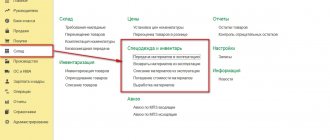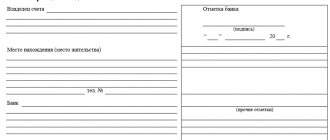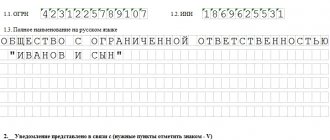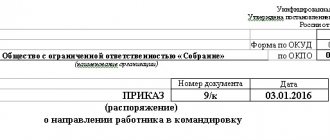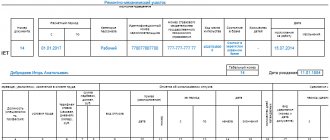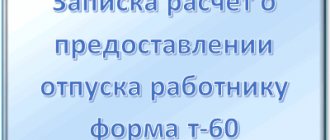How the form is structured. Key Features
Personal cards of employees are the necessary basis for creating a card index of all employees of the institution. They are stored in a file cabinet in alphabetical order. If there are many employees in an institution, then the documents can be structured by department. There are no clear legal requirements for filing a file cabinet. All that is needed is for each employee to have a personal card in the T-2 form.
Form T-2 consists of 4 pages. The information in it is divided into 11 thematic blocks. The card must be filled out by a person from the personnel service, and if this is impossible for some reason, by the head of the institution.
Form T-2 has several important features:
- Pages 1 and 2 are filled out at the time a person is hired for a position, and 3 and 4 - during the process of his work; (the images below and the sample itself are designed specifically for the document that you create when an employee joins you;
- the card is created based on a number of documents presented by the employee himself;
- for simpler and more convenient filling, the use of computer programs is allowed;
- issuance of a T-2 card by the employee himself is not allowed.
Important! Only entrepreneurs are exempt from the obligation to create personal cards. But even they often keep cards of their own accord in order to use them in management work.
General information about filling out the card
The legislation does not establish clear deadlines for creating a T-2 card. The best option is to create it at the time a person is hired for a position, but you can wait. The main thing is that the note in the work book about hiring for the position is duplicated on the card.
To successfully create a T-2 card, a number of papers are required:
- employment contract;
- an order issued by the employer;
- passport;
- work book (or other way of confirming work experience);
- certificate of pension insurance;
- diploma or other evidence of education, qualifications, special knowledge;
- for persons who may be drafted into the army - military registration documents;
- autobiography (optional - the employee can provide information orally).
Important! The specifics of the job for which a person is hired sometimes necessitates the provision of additional documents. The employer is obliged to request them so that the information on the T-2 card is complete.
To fill out section 2, which contains information about military registration, you will need the following documents:
- for people in the reserve - a temporary certificate or a full-fledged military ID;
- for people who may be drafted - confirmation that the person is subject to draft.
Valentina Mitrofanova: what happens if the employer does not keep personal cards
Building an effective HR service 3.0. A complete package of knowledge for the HR manager
27964
The latest HR course 3.0. A complete package of knowledge for a HR specialist
31672
Work books: paper and electronic. New rules from 09/01/2021
14469
Why do you need a personal card?
1. Storage and systematization of information. A personal card is a kind of employee dossier. In a condensed form, the card contains all the information about him: passport data, registration address, specialty, diploma number, level of foreign language proficiency, family information, etc. An employee of the HR department has the right to use a personal card in their work. For example, a personnel officer can create any benefits for an employee based on the family composition indicated on the card. An accountant can also use it - T-2 may contain information that is the basis for any additional payments. Separate records of a specialist’s qualifications can help him take a higher position or expand his functionality.
2. Document important changes. Date of entry to work, order number, transfer from one job to another, promotion, awards and incentives - all this is important information about the employee. Of course, they are accompanied by timely orders, schedules, acts and other things - however, the entire amount of knowledge about these changes is contained in the personal card - they can be seen chronologically. Storing data on a single T-2 form will help avoid misunderstandings or conflict situations. A large amount of information can be restored in case of loss. The employee signs on a personal card about all changes occurring in his career, certifying with his signature his acceptance of these changes and agreement with them.
3. Military registration. The employer is required to keep records of employees (this is specified in the Federal Law “On Military Duty and Military Service”). The accounting itself is carried out using personal cards, in which the corresponding section is filled out. Also, the employer, having filled out a personal card, must explain to employees liable for military service the procedure for fulfilling their military duty.
4. Statistics and food for thought. In general, information from T-2 can serve as a kind of database about the organization’s human resources. After analyzing this data, the enterprise administration can draw conclusions about the qualifications of its specialists, their successes and career paths, and use this knowledge for the development of the company.
What types of cards are there?
There are two official forms of cards - the usual T-2 and for a civil servant T-2GS (MS). The forms differ only in that for a civil servant, the length of service in the civil service is separately indicated, which gives the right to bonuses for length of service and to additional payments to the pension.
How to fill out the header of an employee’s personal card
The header contains OKUD and OKPO codes. In this case, OKUD is the code of the card itself, and OKPO is the code of the institution, based on statistical data. In addition, you must enter the full name of the institution (abbreviations are not allowed). After the name you need to put a comma and write the address (preferably actual, not legal). This is at your discretion; we did not indicate it in the example.
Next comes a small table, which is filled out as follows:
The date is entered in the format DD.MM.YYYY (for example, 08/01/2016). A personnel number is a serial number assigned to an employee in an institution. a TIN . A person is not required to provide it when applying for employment, so the field can be left blank. SNILS (insurance number) is required. A person must provide it in connection with Part 1 of Article 65 of the Labor Code of the Russian Federation. If this is his debut employment, then in connection with Part 4 of the same article, SNILS must be issued by the employer. “Alphabet” is a field for entering the initial letter of the employee’s last name. The nature of the work is entered based on the employer’s order. It can be permanent or temporary. Gender can be indicated by the letter M/F, or you can write the whole word.
Filling out the T-2 form by section
Section 1. General information
This section must be filled out with information from the employee's passport. Information must be entered legibly, without abbreviating anything. There are features that must be taken into account when filling out:
The date of birth is entered in its entirety (for example, May 23, 1982), and in the “Code” field it is duplicated in the format DD.MM.YY (05/23/82). The place of birth entry cannot be longer than 100 characters. You can use geographical abbreviations (city, region, village, etc.), but words such as village, village, kishlak, aul must be written in their entirety. If you have dual citizenship, you must indicate the name of the country of which the employee is a citizen. The name of the educational institution that the employee graduated from can be abbreviated without compromising the meaning. The length of service must be calculated on the basis of paragraph 61 of the Instructions, which was approved by Resolution No. 192p of the Pension Fund Board. The full names of family members are entered in full, without abbreviations.
If the registration and place of actual residence are identical, then the address does not need to be duplicated. The second column is simply not filled in.
The most difficult point in section 1 is encoding. Errors in them are unacceptable:
OKATO - locality code approved by Resolution No. 413 of the State Standard of the Russian Federation; OKIN – employee citizenship code (Russian Federation citizenship – 1, dual – 2, foreigner – 3, no citizenship – 4); OKSO - code of the profession or specialty acquired by the employee in the process of education; OKPDTR is another form of specialty code.
Important! The HR employee has access to all encodings. He cannot demand these codes from the person for whom the card is created.
Section 2. Information on military registration
Military records are used to complete this section. There should be no difficulties when filling out, because the requirements of the T-2 card are extremely clear. However, there are several important features:
Item 1 does not need to be completed if the person applying for the job is a reserve officer. Point 3 is filled in without any abbreviations. Point 7 may change, so fill it out in pencil. Section 2 must be reviewed and signed by the HR Inspector. In addition to the signature, its transcript and the position of the inspector must be indicated. The employee must also sign this section.
Section 3. Hiring. Translations
The employee’s length of service completely depends on this section, so mistakes are unacceptable. The main document to fill out is the manager’s order. All information indicated in section 3 must be duplicated in the workbook. The employee must sign all entries in the section.
Section 4. Certification
The main point of this section is “Decision of the Commission”. This column should contain official wording, such as “suitable for the position held.” In case of discrepancy, “does not comply” is written, and if re-certification is necessary, this is indicated in the decision of the special commission.
The dates of certification and creation of the protocol are recorded in the format DD.MM.YYYY. The basis for filling out this section is the document issued to the person at the time of certification.
Sections 5-6. Training. Professional retraining
These sections are filled out according to the documents of the person applying for a job, or according to information from the personnel training department. There are no particular difficulties in filling them out. Dates must be specified in the format DD.MM.YYYY. Completing all sections is mandatory (except in cases where there is nothing to write - for example, in the absence of qualifications or retraining).
Section 7. Awards
This section includes any types of incentives that the employee received during his working life. The grounds are Article 191 of the Labor Code of the Russian Federation and local acts. In addition to notes on awards and honorary titles, they need to be listed. Abbreviations are acceptable if they do not entail a loss of meaning.
Section 8. Vacation
This section provides information about each leave received by the employee:
- regular annual leave;
- leave without pay;
- leave to care for a child.
It is necessary to indicate the type of leave, its time frame, duration and reasons for granting. If the vacation was used in parts, the working year is still calculated in full.
Important! If an employee works in an institution for a long time, then the vacation section will overflow. After this, an “Addendum to the employee’s personal card” is created. This addition should have a header similar to the header of the main document, as well as a tabular part of the missing section.
Section 9. Social benefits
This section includes all information about the benefits provided to the employee in accordance with the legislation of the Russian Federation.
Section 10. Additional information
You don't have to write anything at all in this section. The only basis for filling it out is the desire of the employer. This may contain information about the employee’s studies, attendance at certain courses, disability group, etc.
Section 11. Termination of an employment contract
The features of filling out this section are the same as those of section 3. The only difference is that the signature must be signed not only by the employee, but also by the HR inspector. The date of dismissal is the day on which the employee last actually performed his or her job.
Rules for filling out the second section of your personal card
| Paragraph | How to fill out |
| Stock category | Not to be filled out for reserve officers and future conscripts. In other cases, the number 1 or 2 is put in accordance with the data on the military ID. |
| Military rank | To be completed for all persons liable for military service. For a former military man, his military rank is recorded in his personal card according to his military ID, and for a future conscript, the following entry is made: “Subject to conscription.” |
| Composition (profile) | It is not filled out for conscripts. For those who have not risen to the rank of officer, the composition is written in this paragraph, for example, “Soldiers”, “Sailors”, “Ensigns”. For officers, instead of composition, you need to indicate the profile - “Command”, “Medical”, etc. |
| Full code designation VUS | VUS is a military specialty. You will find its code on the employee’s military ID. This item is not completed for future conscripts. |
| Category of suitability for military service | Only the letter is entered, without decoding: A - fit for military service; B - fit for military service with minor restrictions; B—limitedly fit for military service; G - temporarily unfit for military service; D - unfit for military service. |
| Name of the military commissariat at the place of residence | The name of the military registration and enlistment office where the employee is registered. |
| Registered with the military | Filled out if the military ID contains marks on mobilization orders or if the employee is booked for the period of mobilization and during wartime (in this case, he must have the appropriate ID). All entries in paragraph 7 must be made in pencil. |
| Mark on removal from military registration | If an employee has reached the age limit for being in the reserves or is declared unfit for military service due to health reasons, a note must be made in paragraph 8: “deregistered from military registration due to age” or deregistered from military registration due to health reasons.” |
Common mistakes when filling out the T-2 form
It happens that HR employees make mistakes in an employee’s personal card. This does not have any special consequences, and it does not harm the employee himself. But if there are a lot of errors, then during an external audit the HR department may be fined for poor quality work.
The main mistakes that occur most often:
Using special characters
The slash (/) , colon (:) , equal sign (=) and other special characters cannot be used in the T-2 form. They are especially strictly prohibited in the coding zone. Inaccurate filling. Text may extend beyond the intended margins if necessary. But he should not go into the coding zone. If there is at least one letter in this zone, the card will formally be considered damaged and will need to be rewritten.
Dashes
This common mistake is because in many other documents, dashes are acceptable or even required. They should not be in the T-2 form. If there is nothing to write in the column, then it should be left completely empty.
Filling out a form on a computer
The initial filling out of T-2 (upon hiring) can be done on a computer or manually. But notes made during the employee’s work must be done strictly by hand! The employee must be familiarized with these records against receipt.
Important! A damaged card (see error 2) can only be rewritten upon initial completion. If the document was damaged during subsequent entries, it cannot be rewritten or reprinted.
We hope this material helped you obtain a personal employee card. Don't forget to save the page on social networks - it will come in handy!
Are personal T-2 cards required for employees?
An employee’s personal card in the T-2 form is one of the documents that is prepared by a HR specialist for each employee hired into the organization’s staff. The obligation to prepare this accounting document was previously dictated by clause 12 of the Decree of the Government of the Russian Federation No. 225 of April 16, 2003.
In this form, in accordance with the specified legal acts, information about the professional activities of the employee is entered, including duplicating the information available in the work book.
A personal card is created upon employment on the first working day of a specialist, and in the event of his dismissal or death, it is closed, after which it continues to be stored for 50 years in the archives of the enterprise. In the event that the termination of an employment contract with a subordinate occurred before January 1, 2003, the period for storing a personal card in the archive was 75 years.
Many employers are concerned about whether it is necessary to adhere to the T-2 form when issuing a personal card for an employed employee. In this case, we can refer to court decisions that believe that the use of a unified form is no longer relevant for Russian employers. The judges refer to the fact that the personal card of the T-2 employee is not in the list of primary accounting documents required for the organization, according to information from the Ministry of Finance No. PZ-10/2012.
As an example, we can cite the Decision of the Vyshnevolotsk City Court of the Tver Region in case No. 2-412/2019 dated 01.04. 2019
V.V. Razgulov filed a lawsuit against the employer with a demand to correct violations when filling out a personal card and enter data into it in accordance with the law. As a result of the consideration of the case, the court sided with the organization, noting that the employer is not obliged to adhere to the T-2 form when filling out a personal card.
The court referred to Law No. 402-FZ of December 6, 2011. Having entered into force on January 1, 2013, this regulatory act made it unnecessary for commercial organizations to use unified forms of primary documents. In this connection, it is allowed to issue a personal card in free form, for example, on the organization’s letterhead.
Thus, all employers are required to create personal cards for hired employees. In this case, the cards, at the discretion of the management, can be issued either in the T-2 form or in any form. For example, you can add company details, additional lines and columns to the form. The T-2 GS VUR card form, recommended by the military registration and enlistment office, can be used in state or municipal service.
It is important that the personal card includes all mandatory information about the employee’s work activities. This will exclude claims from inspection authorities.
Despite the fact that employers are switching to maintaining information about the work activities of subordinates in electronic form, nevertheless, filling out employees’ personal cards remains in the usual format. The personnel officer is obliged to draw up the document in paper form and familiarize the employee with each entry made in it for signature.
